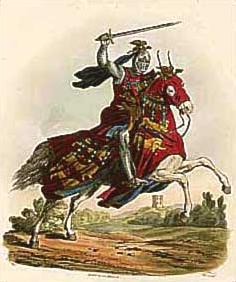- Thomas Plantagenet, 2nd Earl of Lancaster
Infobox British Royalty|royal
name =Thomas Plantagenet
title =Earl of Lancaster, Leicester and Derby

imgw= 180px
spouse =Alice de Lacy
titles =The Earl of Lancaster
The Earl of Leicester
The Earl of Derby
royal house =House of Plantagenet
father =Edmund, Earl of Lancaster
mother =Blanche of Artois
date of birth = abt1278
date of death =22 March 1322 (aged 44)
place of death =Pontefract ,Yorkshire |Thomas, Earl of Lancaster (c. 1278 –
March 22 1322 ) was one of the leaders of thebaron ial opposition toEdward II of England .Lineage
Thomas was the eldest son of
Edmund Crouchback, 1st Earl of Lancaster andBlanche of Artois . His paternal grandparents wereHenry III of England andEleanor of Provence . His maternal grandparents wereRobert I of Artois andMatilda of Brabant , who was a daughter ofHenry II, Duke of Brabant .Titles and lands
From his father Thomas inherited the Earldoms of Lancaster, Leicester, and Derby.
By his marriage to
Alice de Lacy, Countess of Lincoln , daughter ofHenry de Lacy, 3rd Earl of Lincoln , he becameEarl of Lincoln ,Earl of Salisbury and the 11th Baron of Halton upon the death of his father-in-law in 1311. Master of fiveearldom s, he was one of the wealthiest and most powerful men in England.Thomas was in possession of many key fortesses, particularly in northern England. He was responsible for the extension ofPontefract Castle and in 1313 he began the construction ofDunstanburgh Castle a massive fortress inNorthumberland .Marriage
His marriage to Alice de Lacy was not successful. They had no children, though he had two illegitimate sons. In 1317 she was abducted from her manor at
Canford ,Dorset by Richard de St Martin, aknight in the service ofJohn de Warenne, 8th Earl of Surrey . This incident caused a feud between Lancaster and Surrey; Lancaster divorced his wife and seized two of Surrey's castles in retaliation. King Edward then intervened, and the two Earls came to an uneasy truce.Although divorced from his wife, he continued to hold the powerful Earldoms of Lincoln and Salisbury. This was due to the marriage contract the two families had agreed, in effect upon the death of his father-in-law, Earl Thomas held these earldoms in his own right, not in right of his wife.
Conflict with Edward II and death
He served in the coronation of his cousin, King
Edward II of England , on February 25, 1308, carryingCurtana , the sword of StEdward the Confessor . At the beginning of the King's reign, Lancaster openly supported Edward, but as the conflict between the king and the nobles wore on, Lancaster's allegiances changed. He despised the royalfavourite ,Piers Gaveston , who mocked him as "the Fiddler", and swore revenge when Gaveston demanded that the King dismiss one of Lancaster's retainers.Lancaster was one of the
Lords Ordainers who demanded the banishment of Gaveston and the establishment of a Baronialoligarchy . His private army helped separate the King and Gaveston, and Lancaster was one of the "judges" who convicted Gaveston and saw him executed.After the disaster at Bannockburn in 1314, Edward submitted to Lancaster, who in effect became ruler of England. He attempted to govern for the next four years, but was unable to keep order or prevent the Scots from raiding and retaking territory in the North. In 1318 a new faction of barons arose, and Lancaster was deposed from office.
The new leadership, eventually headed by
Hugh le Despenser, 1st Earl of Winchester and his sonHugh the younger Despenser , proved no more popular with the Baronage, and in 1321 Lancaster was again at the head of a rebellion. This time, however, he was defeated at theBattle of Boroughbridge , and taken prisoner.Lancaster was tried by a tribunal consisting of, among others, the two Despensers,
Edmund FitzAlan, 9th Earl of Arundel , and King Edward. Lancaster was not allowed to speak in his own defence, nor was he allowed to have anyone to speak for him. Because of their kinship and Lancaster's royal blood, the King commuted the sentence to mere beheading (as opposed to being drawn, quartered, and beheaded) and Lancaster was convicted of treason and executed nearPontefract Castle .In 1326 or 1327 Parliament posthumously reversed Thomas's conviction, and Henry Plantagenet was further permitted to take possession of the Earldoms of Lancaster, Derby, Salisbury and Lincoln.
Thomas became venerated as a
martyr andsaint within a few months of his death. Hagiographies were written about him, and Edward III wrote three times to thePope requesting hiscanonisation . He was never canonised, though rumours to that effect arose in the 1390s, when his cult experienced something of a revival.Upon his death his titles and estates were forfeited, but in 1323 his younger brother Henry successfully petitioned to take possession of the Earldom of Leicester.
Titles, styles, honours and arms
Arms
Inherited from his father, Thomas bore the arms of the kingdom, differenced by a "label France of three points (that is to say azure three fleur-de-lys or, each)". [ [http://www.heraldica.org/topics/britain/cadency.htm Marks of Cadency in the British Royal Family] ]
References
*cite journal |first=C. |last=Given-Wilson |title=Richard II, Edward II, and the Lancastrian Inheritance |journal=The English Historical Review |volume=109 |issue=432 |month=June |year=1994 |pages=553–571 |doi=10.1093/ehr/CIX.432.553
*cite book |first=J. R. |last=Maddicott |title=Thomas of Lancaster, 1307–1322: A study in the reign of Edward II |publisher=Oxford University Press |location=Oxford |year=1970 |isbn=0198218370
*cite book |first=Ian |last=Mortimer |title=The Greatest Traitor |year=2003 |isbn=0224062492
Wikimedia Foundation. 2010.
